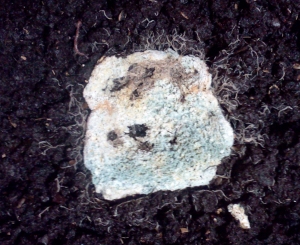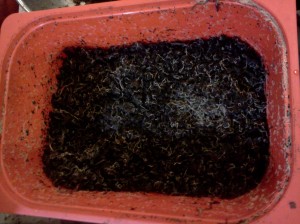The presence of these microdrile annelid (i.e., segmented) worms has become a constant in my worm bins. In Mary Appelhof’s book she mentions these worms and recommends to “leave them alone”; however, their persistent presence – and the feeding swarm behavior they exhibit around foodstuff in the worm bins – warrants further study regarding their function in the worm bin.
In my early days of composting, I misidentified these white worms as “baby” redworms. But young redworms, thin and pale though they may be, are still pinker in color than Enchytraeids. And though the role and function of Enchytraeids appear to be widely much misunderstood, there are several sources that refer to them as ecosystem engineers for their role in decomposition. Specifically, Enchytraeids are becoming more known for their ability to feed on decaying plant matter in agricultural soils as well as more acidic, less developed soils such as peat bogs and coniferous forests.
Many sources point to Enchytraeids’ ability to co-exist, support, and distribute a wide range of beneficial microbes which underscores their importance in a well-rounded nutrient cycling process.
In brief, here is a short list of how their activities may affect the decomposition of your bin material:
- Their burrowing helps to aerate bin bedding, which supports to growth of beneficial aerobic bacteria.
- Their burrowing and ingesting of soil material and organic particles helps distribute fungal spores and bacteria needed to breakdown organic matter.
- Their castings provides food for beneficial bacteria, which they will ingest and excrete helping to cycle nutrients and microorganisms.
- When left alone for 30-45 days in a bin that contains a moderate amount of water, the final effect of their feeding is a black, crumbly compost that feels structurally similar to crumbly mineral clay soil.
Text by Neil Cunningham.
More detailed information on Enchytraeid worms
There are between 600 and 900 described species of annelid worms in the family Enchytraeidae distributed worldwide (Jansch, et al, 2005; van Vliet, 2000). Worms in the Family Enchytraeidae are typically small colorless or pale white worms that live near the soil surface in forests, fields, or peat bogs. They are also common in agricultural systems (van Vliet, Beare, & Coleman, 2004) and in places that are rich in organic matter as well as in the forest floor” (Adl, n.d.). They are generalist decomposers, and their feeding can transform food waste and worm bedding media from loose, slimy sterile media into a crumbly topsoil-like texture. However, several sources question their direct contribution to the mineralization of N-P-K, but they are given indirect credit for mineralization as providing habitat for soil microbes (inside their guts) and helping to disperse beneficial soil microbes horizontally across the upper layers of soil. Because they feed on dead plant material, Enchytraeids are considered saprophytic, meaning they are able to feed on dead organisms, such as fungi, bacteria, yeasts, and even dead Lumbricid worms (Encyclopedia of Soil Science, 2006).By Neil Cunningham, Green NoiseSources
1. Adl, S.M. n.d. Enchytraeids [Chapter 35]. Retrieved from http://soilecology.biology.dal.ca/Reading%20Picks%20Assets/Chap-35-enchytraeids-Adl-editor%20revised.pdf
2. van Vliet, P.C.J. 2000. Enchytraeids [chapter]. In Handbook of Soil Science [Malcolm Sumner, editor]. Accessed at Google Book Preview.
3. Jansch, S., Rombke, J., & Didden, W. October 2005. The use of enchytraeids in ecological soil classification and assessment concepts. Ecotoxicology and Environmental Safety, 62: 2.

